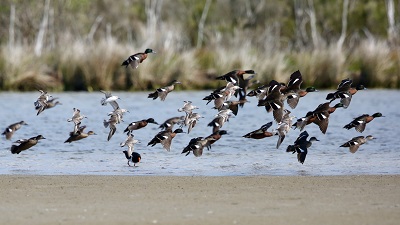Proceedings of the Royal Society of Victoria
Volume 136
Number 1 2024
This paper is the introduction to a collection of papers arising from a Royal Society of Victoria roundtable on the future of the Gippsland Lakes.
This article belongs to the collection: Gippsland Lakes Roundtable.
The environmental health of the Gippsland Lakes substantially depends on freshwater inflows. The quantity and quality of this water is being reduced by the impacts of agriculture, mining, and water transfers to Melbourne. These impacts will be exacerbated by both the direct impacts of climate change and thirsty measures adopted by society to respond to climate change. Changes in water use and increased investment in natural resources management are needed to effectively adapt.
This article belongs to the Collection Gippsland Lakes Roundtable.
The Gippsland Lakes contains Australia’s best-preserved beach-dune system dating back more than 200,000 years. This review shows how the shape of the modern coast is related to past, especially higher, positions of the sea. We suggest urgent action is required to understand future sediment movement as the beaches may be shifting into a long-term erosional phase.
This article belongs to the Collection Gippsland Lakes Roundtable.
The Gippsland Lakes form Australia’s largest estuary and is a productive recreational fishery. Algae underpin the productivity of this fishery and most of the time go unnoticed. However, in some years, blooms of cyanobacteria (‘blue green algae’) occur, closing areas of the lakes to fishing and recreation. Here we review the factors that drive different algal growth, how this might have looked historically and how cyanobacteria blooms can be mitigated in the future.
This article belongs to the Collection Gippsland Lakes Roundtable.
The Gippsland Lakes is 1 of 12 wetland systems in Victoria listed under the Ramsar Convention on Wetlands. Several decades of monitoring by BirdLife Australia reveals marked changes in abundances of many species. Apparent decreases may reflect changes in foraging habitat, movement of birds out of the system in response to rainfall, and gaps in survey coverage. A comprehensive analysis of waterbird distribution and abundance in key habitats is urgently required. Photograph of waterbirds in flight over Gippsland Lakes by John Hutchinson.
This article belongs to the Collection Gippsland Lakes Roundtable.
The latest climate change information that relates to the Gippsland Lakes in eastern Victoria is reviewed. Rising sea levels are a major concern for this low-lying region. Changes to weather and circulation systems may also change coastal storm surges, waves and coastal hazards such as inundation and erosion.
This article belongs to the Collection Gippsland Lakes Roundtable.
Anthropocene conditions challenge traditional governance models for large, complex ecosystems. In this paper we lay out some ideas about the characteristics of governance models that are appropriate for the social–ecological system of the Gippsland Lakes.
This article belongs to the Collection Gippsland Lakes Roundtable.
When did life move from the sea to the land? Some claim evidence for this important step in evolution can be found around Yea, in central Victoria, and this study for the first time connects the geology at Yea with the rest of Victoria to significantly improve the dating of its fossil life. The fossils at Yea are internationally significant, and the improved dating contributes to the global timeline of evolution.
This paper describes a new species of very small thecideid brachiopod from the Kermadec Islands. The paper includes a series of images showing the development of the important structures in the dorsal valve from a tiny juvenile to an adult, for the new species, and also for a second species from Lord Howe Rise. These developmental series are important as thecideid brachiopods go through a lot of change during their development.
The input of nutrients is a major issue for the health of coastal environments around the world. This review shows that the environmental health of Port Phillip Bay, Australia, can be affected by both excessively high and low nutrient inputs. Coastal managers have traditionally focused on the effects of high nutrients; however, this review shows that low nutrient inputs also need to be considered.





